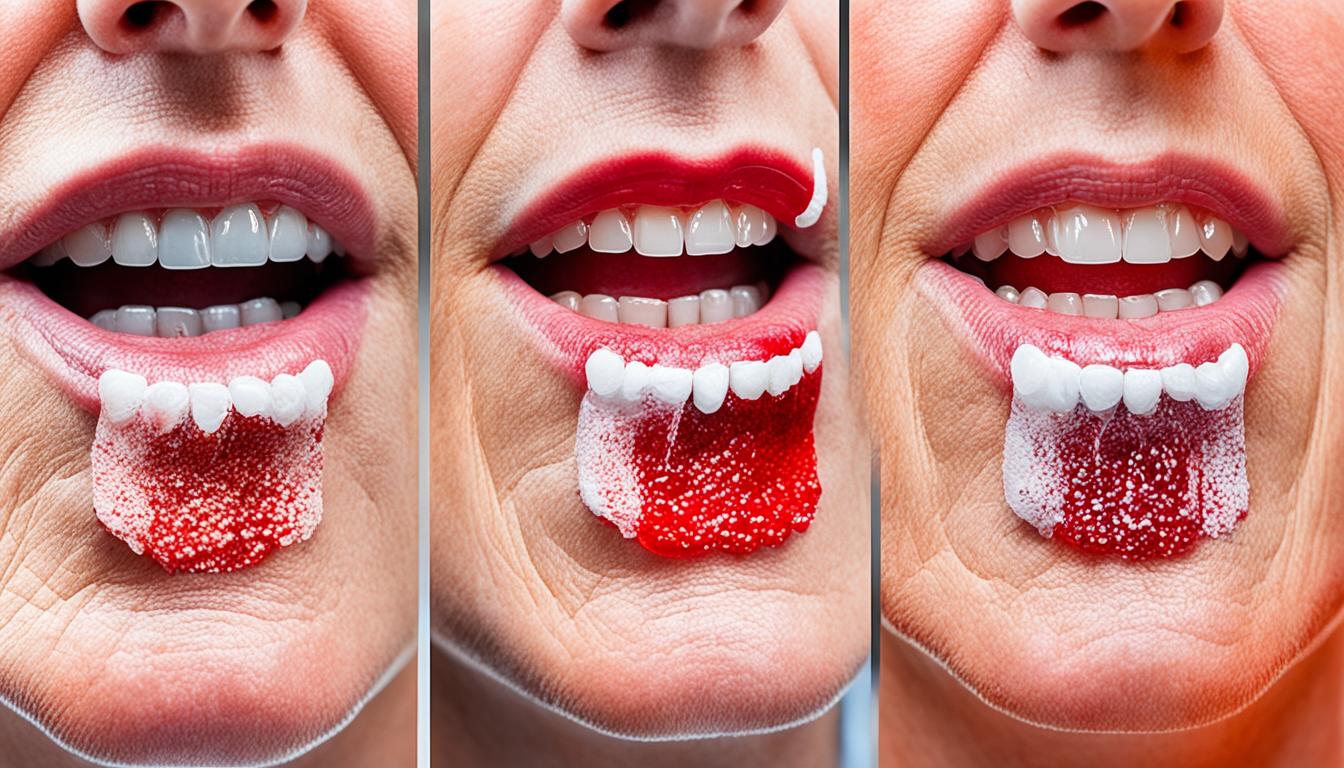Lichen planus is a long-lasting inflammatory condition that mainly affects people over 40. It shows up in the mouth, on the skin, and in private areas, as well as in other spots. We don’t fully know what causes oral lichen planus, but both genes and the environment play a role.
This disease can look different from person to person. It might show up as spots, thin areas, sores, thick patches, bubbles, or red, swollen gums. Sometimes, it can look like a skin reaction or mimic oral lichen planus.
Spotting oral lichen planus can be tough and might need a specialist’s help. Doctors often use strong creams for short-term relief and plan ongoing care carefully. Dentists should watch out for any signs the condition could turn into cancer and keep an eye on their patients.
Key Takeaways:
- Oral lichen planus is a chronic inflammatory condition that primarily affects adults over 40.
- Genetic and environmental factors are believed to contribute to the development of oral lichen planus.
- It can present with various clinical manifestations, including reticular, atrophic, ulcerated/erosive, plaque-like, bullous, and desquamative gingivitis, as well as oral lichenoid lesions.
- Diagnosing oral lichen planus can be challenging and may require referral to specialist services.
- Stem cell therapy has emerged as a promising treatment option for oral lichen planus.
Risk factors, associated comorbidities, and diagnosis of oral lichen planus
Understanding oral lichen planus is key to managing it well. Knowing the risk factors, other illnesses it might connect to, and how to diagnose it, helps a lot.
Many things can cause oral lichen planus. These include genetics, certain environments, and immune system issues. It’s also linked to other autoimmune diseases, like thyroid problems and ulcerative colitis. Liver diseases and hepatitis C can play a part too.
Diagnosing oral lichen planus involves closely looking at the mouth and a patient’s health history. Sometimes, a biopsy is needed to tell it apart from oral lichenoid lesions. This helps decide the best way to treat and manage it.
Because it could turn into cancer, keeping an eye on oral lichen planus is crucial. Dentists and doctors should watch for any signs that the condition might be getting worse.
With the right knowledge and diagnostic tools, medical teams can do a lot for those with oral lichen planus. Catching it early and taking action are key to helping patients maintain their health.
Stem cell therapy for oral lichen planus – an emerging treatment option
In recent years, stem cell therapy has shown great promise for oral lichen planus management. It can help repair damaged tissues and control the body’s immune response. This makes it a hopeful treatment for this long-lasting inflammatory disease.
Various types of stem cells, like those from bone marrow, fat tissue, and umbilical cord, are being used. They can be given to patients in different ways, such as injections or creams. The goal is to soothe the inflammation, heal the tissues, and fix the immune system.
Though more studies are required to fully prove its safety and effect, early findings are encouraging. Patients have seen their symptoms get better and their oral lichen planus sores shrink. This treatment might be a new way to help those with the condition, offering light at the end of the tunnel.
FAQ
Q: What is oral lichen planus?
A: Oral lichen planus is a long-term inflammatory issue. It mainly affects adults over 40. This condition can cause different symptoms, like sores, white patches, and red, swollen gums.
Q: What are the risk factors and associated comorbidities of oral lichen planus?
A: The risk factors for this issue include your genes, things in your environment, and problems with your immune system. It’s linked to diseases like issues with your thyroid or colon. It’s also been connected to some liver problems and hepatitis C.
Q: How is oral lichen planus diagnosed?
A: Diagnosing involves a detailed check-up, talking about your health history, and maybe a small tissue sample. This sample, called a biopsy, helps the doctor tell the difference between this issue and similar ones. Because there is a risk of this issue turning into cancer, monitoring your health is very important.
Q: What is stem cell therapy, and how does it relate to oral lichen planus?
A: Stem cell therapy is a new way to treat oral lichen planus. It uses cells to heal damaged areas and to help the immune system work better. Different types of stem cells, coming from things like bone marrow, fat, or umbilical cords, can help lower swelling, fix tissue, and help the immune system work like it should.
Q: What are the treatment options for oral lichen planus?
A: Doctors often use creams with corticosteroids to calm symptoms at first. But, only a specialist can figure out the best plan for the long run. Lately, treatment with stem cells is showing good signs of stopping the problem and making it better.
Q: Can stem cell therapy help manage oral lichen planus?
A: There is hope that stem cell therapy could be a good way to treat oral lichen planus. Although we need more research to be sure, there are early signs that it might help. People in studies have seen their symptoms improve and their sores get better with this therapy.
Q: What are the benefits of stem cell therapy for oral lichen planus?
A: Stem cell treatment aims to lower swelling, fix tissues, and make your immune system act right. It could be a new choice for those tired of traditional treatments. This offers hope to people fighting the effects of oral lichen planus.

